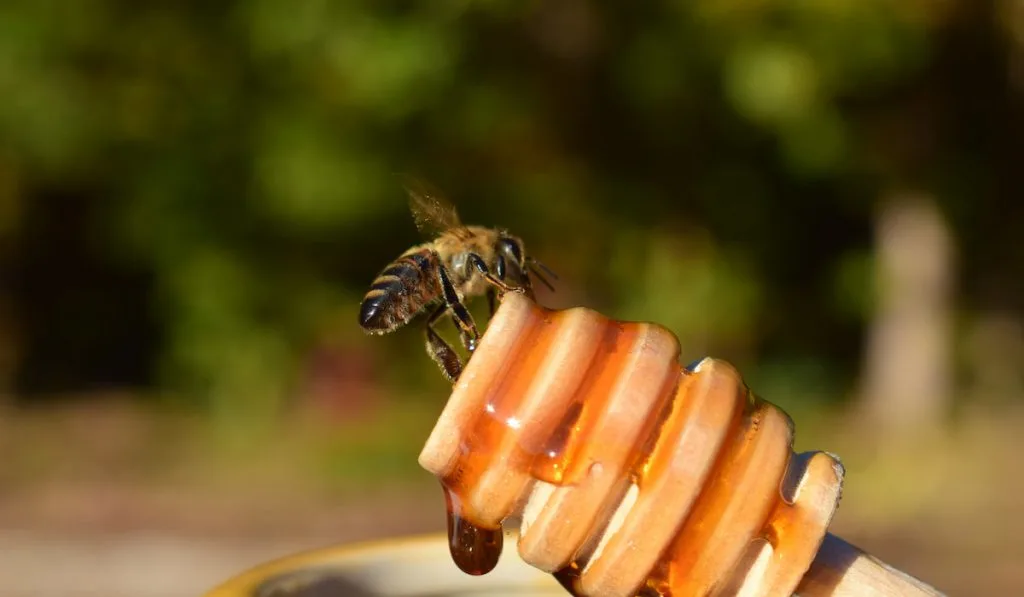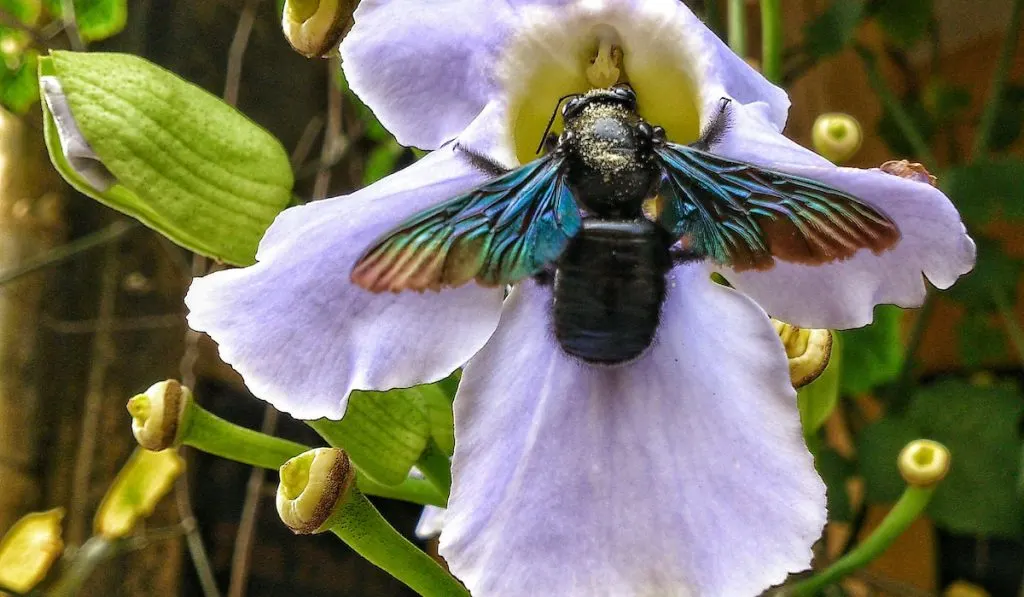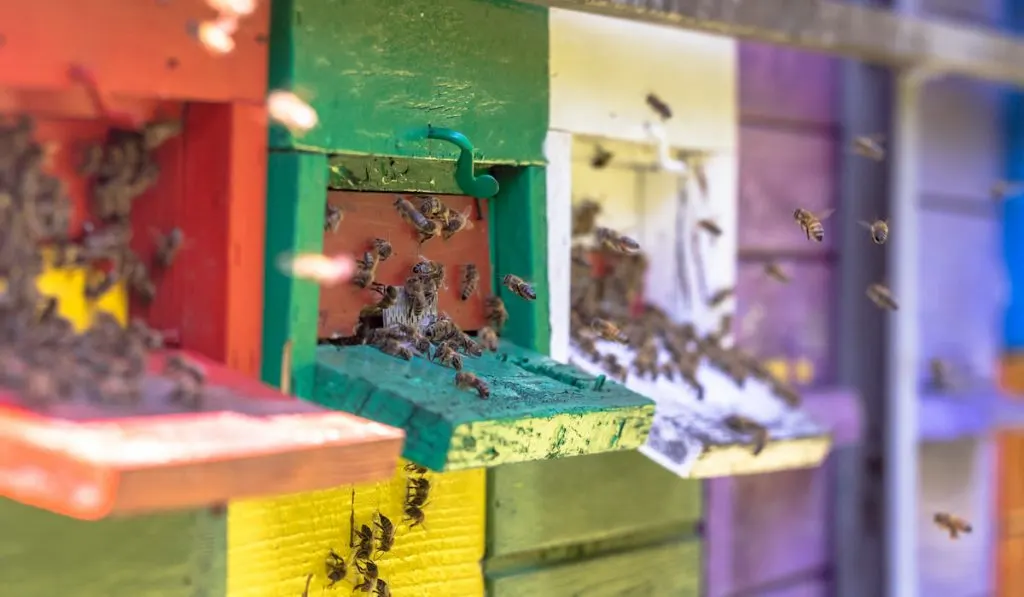*This post may have affiliate links, which means I may receive commissions if you choose to purchase through links I provide (at no extra cost to you). As an Amazon Associate I earn from qualifying purchases. Please read my disclaimer for additional details..
Bees are creatures that thrive and live as part of a community. But they are also unique insects that can capture our imagination and even tempt us to keep them for enjoyment.
Can a bee be a pet?
A bee should not be kept as a pet. Keeping a lone bee is not ideal as it poses a number of issues including habitat and feeding. Bees are also very small and unaccustomed to being alone or in very small groups.
In fact, bees are generally unable to live comfortably in unfamiliar environments or climates, including a house, and they will become anxious and potentially aggressive out of their natural habitat.
While not recommended, it is possible to keep most types of bees in the house.
If you have other pets such as dogs or cats, you may need to take extra precautions and determine whether they have any allergies that could cause complications.
The common bee has the ability to recognize a human face and may overall build a trusting relationship, which plays a key role among beekeepers especially for commercial purposes.
| Type of bee | Can it be a pet? | Native to |
| Honey bee | Yes | Africa |
| Bumblebee | Yes | Northern America |
| Carpenter bee | Yes | United States |
| European dark bee | No | Northern Europe |
Table of Contents
Types of Bees
There are a number of different bee species across the world although some types are more common than others. They all tend to build hives in warm, sunny places where flowers have high rates of growth, perfect for the production of honey.
Below is a closer look at the most common types of bees and whether you should risk keeping them as pets.
Honey Bee

Honey bees may be kept as a pet.
The honey bee, originating in Africa, has become one of the most popular species across the world. Honey bees are less aggressive than other species, which may allow for them to be held in captivity.
However, they are still community-built insects and enjoy being part of a hive. They can be kept in a small cage-like box with many holes to allow for air.
But after only a few hours without being among other bees and being free to fly around, they may become upset, aggressive, and even lead to death.
Overall, honey bees may be kept as pets for a short period of time. Whether for a science project or just for fun, they should not be kept for more than 48 hours.
Bumblebee
Bumblebees may be kept as pets. Similar to the honey bee, these animals originate from America and can be found across the world.
They are commonly found gathering pollen and creating honey in their hive.
In fact, bumblebees are actually more efficient making honey than honey bees. This may be because they are much more interested in holding of pollen than they are interested in nectar.
While you can keep a bumblebee as a pet, this is generally not a good idea. Much like the honey bee, they are most happy in groups and their own kind.
When alone in captivity, they may get overwhelmed and become aggressive.
Carpenter Bee

A carpenter bee can be a pet for short periods of time.
The carpenter bee, originating in the United States, is now found across the world. Unlike the common bumblebee, they can be distinguished by their large size and black bodies with yellow toward the front.
They may look scary since they quite large. However, carpenter bees are friendly and do not commonly sting.
Males are more aggressive when provoked and may sting when feeling threatened. The females are more relaxed and will only sting if directly provoked.
These bees are very good at pollinating as well and enjoy working with a community of bees. This means they do not enjoy being alone and held in captivity.
They can be kept as a pet for short amounts of time but should not be held for more than 48 hours. Otherwise, you run the risk of the bee becoming agitated and hurting someone.
European Dark Bee
European Dark Bees should not be kept as pets. Originating in northern Europe, these bees are commonly found in countries such as Germany and Russia.
These bees are known to be calm but have the potential to become aggressive, especially in groups. If feeling threatened, they may attack in colonies from a hive.
If you keep European dark bees in captivity, they will become upset and aggressive and even die if isolated for long periods of time. These bees should not be kept longer than 24 hours to decrease the chance of an angry hive swarming your house in retaliation.

Can You Pet a Bee?
You can likely pet a bumblebee without it becoming aggressive.
Remember that just like all animals, when feeling threatened or in danger they will become upset, anxious, and may become aggressive. This can be the case when you are too rough when touching them.
Bees of any kind are very small and delicate and should be treated as such. Do not squeeze them too hard when attempting to pick them up and pet them.
If you want to pet a bee, you should only use one or two fingers at a time.
Bees are known to have bonding abilities, meaning they are able to recognize a human’s face and know if they are safe or in danger. This allows for a bond to be formed and overall a better relationship.
Bee stings can be painful and even cause allergic reactions to some. Do not keep a bee as a pet without having the knowledge of an existing bee allergy.
Can You Pet a Bee without Being Stung?
You can pet a bee without being stung. It is possible to hold and pet a bee without any repercussions.
Bees are solitary creatures and are not openly violent. Much like other animals, they are only aggressive when becoming stressed and feel threatened.
When the bee stings after becoming aggressive, it has a higher chance of dying. This is because when the stinger is injected into the skin, the barbs on its edges attach firmly.
When trying to get out of the skin, the stinger can be damaged or pull out part of the digestive tract. This abrupt and massive rupture often leads to a quick death.

What to Feed a Pet Bee
Bees are easygoing and may enjoy a wide variety of foods and substances to quench their thirst and hunger. This include a mixture of water and sugar.
If you make a sugar water for your bees, use real, natural sugar and not an artificial sweetener with added chemicals and flavors. These alternatives can cause digestive issues and lead to illness.
This mixture should consist of a small spoon of sugar and two spoons of water. This may be given in a small dish in front of the bee or inside their habitat.
Bees may also enjoy the tastes of fruits and vegetables.
Contrary to popular beliefs, you should not feed bees honey. It is high in sugar and nectar which can cause stomach and digestive issues for the bees, leading to illness and death in some cases.
Reasons Not to Keep a Pet Bee
Bees can be kept as short-term pets, but it is generally not a good idea to keep them in captivity. Below is a list of reasons why having a pet bee may be a bad idea:
- Your pets, including dogs and cats, may become spooked by a bee or have an unknown bee allergy
- You or someone in your household may have an unknown allergy to bees, which can create illness and life-threatening conditions
- They are very small and hard to keep track of.
- They have stingers and may become aggressive when stressed or anxious.
- They are hard to care for.

How to Release a Bee Back Into the Wild
Bees are happiest when out in the wild with their hive.
If you change your mind about keeping a pet bee, it is important to know how to get them out of your house safely and easily to avoid aggression. This can also be helpful if a bee accidentally makes its way into your home.
Here are some of the most common ways to safely release a bee back into the wild:
- Sugar Water: Put out some sugar water for your bee. When the bee is drawn to the water, put a cup over it and slide a piece of paper under, creating a trap for the bee. You can then safely relocate it outside.
- Cinnamon: If a hive is nearby, put cinnamon outside the hive. The smell may attract the bee out of your house and back to their hive.
- Daylight: Bees are early risers so they are most active in the earlier parts of the day. Use daylight at windows to attract a bee closer to an exit.
- Windows: Open a window and close the door to the room where the bee is located. This will keep the bee from moving around your home and give it a chance to naturally leave your home.
Important Note
This information is not suitable for medical advice. This article is strictly information given to inform you of the risk and potential of having a pet bee. It is important to be careful and stay safe.
If you or a loved one show signs or symptoms of heavy breathing or abnormal behavior patterns, this may be the result of an allergic reaction. Seek medical attention immediately.
Resources
- https://www.woodz.co/journal/you-can-now-keep-bees-as-indoor-pets/
- https://www.fs.fed.us/wildflowers/pollinators/pollinator-of-the-month/carpenter_bees.shtml
- https://www.fs.fed.us/wildflowers/pollinators/pollinator-of-the-month/carpenter_bees.shtml
- https://en.wikipedia.org/wiki/European_dark_bee
- https://www.reddit.com/r/NoStupidQuestions/comments/68wjp1/do_bumblebees_like_to_be_pet_can_i_pet_a_bee/
- https://blog.onearmenia.org/7-unbeelievable-facts-about-bees-love-d31a510a1f5a
- https://www.bbc.com/news/magazine-29558688
- https://earthsky.org/earth/why-do-bees-die-after-they-sting-you
- https://www.bugtech.com/6-effective-ways-to-get-rid-of-bees-naturally/
- https://www.buzzaboutbees.net/found-a-bee.html
